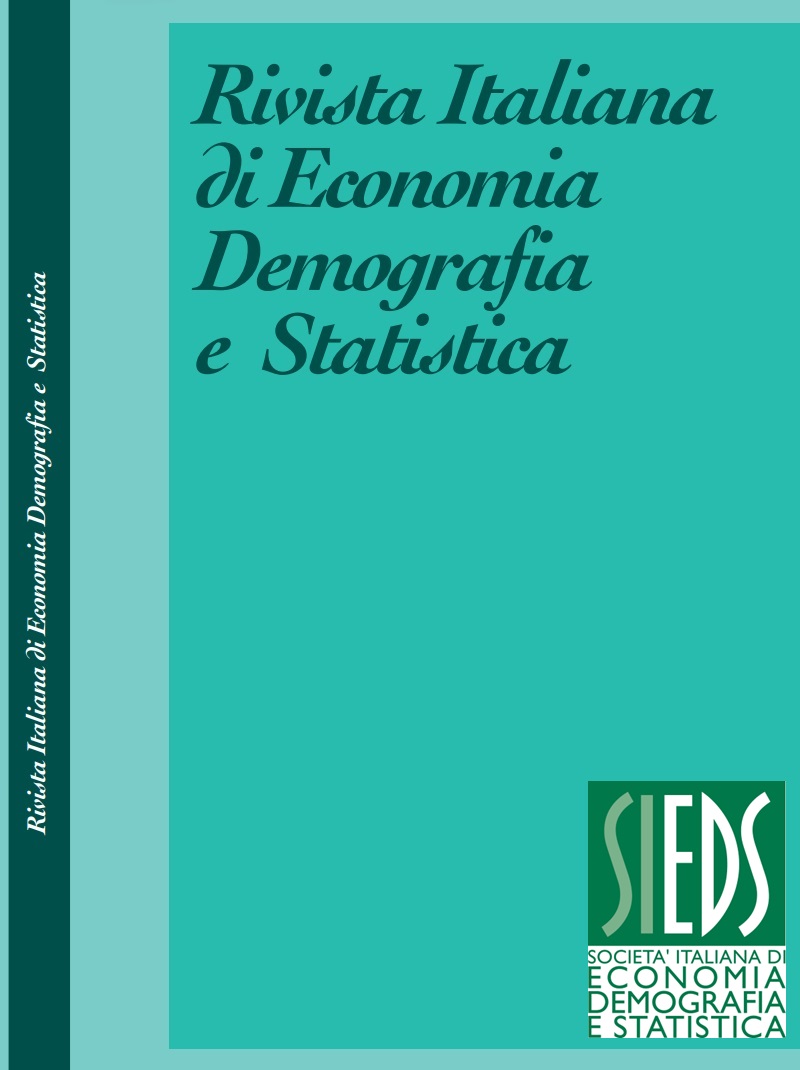Assessing the degree of territorial embeddedness among population subgroups: a first proposal
DOI:
https://doi.org/10.71014/sieds.v79i1.280Keywords:
demography, embeddedness, population balanceAbstract
In studies examining the settlement patterns of foreign communities within a region, the primary aim often involves assessing the level of spatial segregation compared to the native population. However, such analyses typically overlook the assessment of the historical presence of these communities in the region. Particularly with small-sized communities, their long-standing presence in the region becomes a significant factor in characterizing both the community and the region itself. This permanence can be seen as a form of embeddedness. It's important to note that the duration of a subgroup's presence in the population may not align with the individual members' length of stay. In some cases, while individual members may have short stays, the community as a whole may maintain a consistent presence over time due to ongoing turnover. To address this aspect, we propose an index that measures the permanence of a population subgroup within a region over a specified time interval, relying solely on its total balance, observed during that period. This index could serve as a straightforward measure of population stability or rootedness, capturing only the overall gains or losses (in terms of time) within the subgroup rather than focusing on the separate contribution of births, deaths, immigration, and emigration. This index is complemented by the evaluation of its uncertainty, by assuming the goodness of the indicator is based on the stationarity of the historical series of values computed on the sub-periods. To support the utility of this index, we apply it to population subgroups categorized by citizenship in the Metropolitan Area of Milan
References
BILLARI, F. C. 2022. Demography: Fast and slow. Population and development review, Vol. 48, No. 1, pp. 9-30. DOI: https://doi.org/10.1111/padr.12464
BITONTI, F., BENASSI, F., MAZZA, A., STROZZA, S. 2023. From South Asia to Southern Europe: A comparative analysis of Sri Lankans’ residential segregation in the main Italian cities using high-resolution data on regular lattice geographies, Genus, Vol. 79, No. 1, pp. 1-27. DOI: https://doi.org/10.1186/s41118-023-00203-y
CONTI, C., MUCCIARDI, M., SIMONE, M. 2023. Exploring the Settlement Models of the Main Foreign Communities Residing in Italy (2003–2021). Social Sciences, Vol. 12, No. 9, pp. 1-16. DOI: https://doi.org/10.3390/socsci12090524
DICKEY, D. A., FULLER, W. A. 1979. Distribution of the estimators for autoregressive time series with a unit root, Journal of the American Statistical Association, Vol. 74, pp. 427–431. DOI: https://doi.org/10.1080/01621459.1979.10482531
DUNCAN, O. D., DUNCAN, B. 1955. A methodological analysis of segregation indexes, American Sociological Review, Vol. 20, No. 2, pp. 210-217. DOI: https://doi.org/10.2307/2088328
HOOVER, E. M. 1941. Interstate Redistribution of Population, 1850-1940, The Journal of Economic History, Vol. 1, No. 2, pp. 199-205. DOI: https://doi.org/10.1017/S0022050700052980
ISARD, W. 1960. Methods of regional analysis: an introduction to regional science. Cambridge: The MIT Press.
LOGAN, J. R., ALBA, R. D., ZHANG, W. 2002. Immigrant enclaves and ethnic communities in New York and Los Angeles. American sociological review, Vol. 67, No. 2, pp. 299-322. DOI: https://doi.org/10.1177/000312240206700207
MASSEY, D. S., DENTON, N. A. 2019. American apartheid: Segregation and the making of the underclass. In: GRUSKY D. (Ed.) Social Stratification, Class, Race, and Gender in Sociological Perspective, Second Edition, pp. 660-670. Routledge.
PLANE, D.A., ROGERSON, P.A. 1994. The geographical analysis of population with applications to business and planning. New York: Wiley.
PRATSCHKE, J., BENASSI, F. 2024. Population Change and Residential Segregation in Italian Small Areas, 2011–2021: An Analysis With New Spatial Units. Spatial Demography, Vol. 12, No. 2, pp. 1-30. DOI: https://doi.org/10.1007/s40980-024-00124-0
REES, P., BELL, M., KUPISZEWSKI, M., KUPISZEWSKA, D., UEFFING, P., BERNARD, A., CHARLES-EDWARDS, E., STILLWELL, J. 2017. The impact of internal migration on population redistribution: An international comparison. Population, Space and Place, Vol. 23, No. 6, e2036. DOI: https://doi.org/10.1002/psp.2036
RIMOLDI, S.M.L., CRISCI, M., BENASSI, F., RAYMER, J. 2024. Intra-urban residential mobility and segregation of foreigners in Rome, Population Space & Place, e2777 DOI: https://doi.org/10.1002/psp.2777
ROBERTSON, D., MCINTOSH, I., SMYTH, J. 2010. Neighbourhood identity: The path dependency of class and place. Housing, Theory and Society, Vol. 27, No. 3, pp. 258-273. DOI: https://doi.org/10.1080/14036090903326429
ROGERSON, P. A., BAGCHI‐SEN, S. 2023. The average effectiveness of local migration exchanges. Population, Space and Place, Vol. 29, No. 7, e2690. DOI: https://doi.org/10.1002/psp.2690
SENSENBRENNER, J., PORTES, A. 2018. Embeddedness and immigration: Notes on the social determinants of economic action. In: SENSENBRENNER J, PORTES A. (Eds.) The sociology of economic life, Routledge, pp. 93-115. DOI: https://doi.org/10.4324/9780429494338-7
Downloads
Published
Issue
Section
License
Copyright (c) 2025 Stefania Maria Lorenza Rimoldi, Federico Benassi

This work is licensed under a Creative Commons Attribution 4.0 International License.



